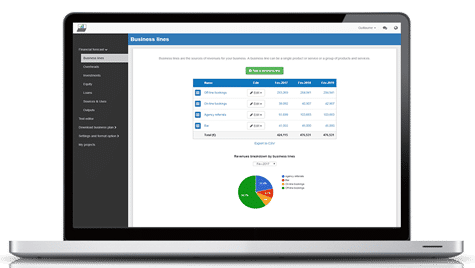How to create a financial forecast for an indoor football venue?
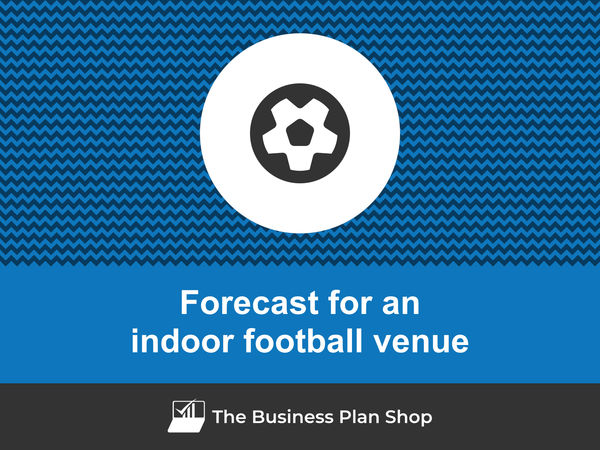
Developing and maintaining an up-to-date financial forecast for your indoor football venue is key in order to maintain visibility on your business’s future cash flows.
If you feel overwhelmed at the thought of putting together an indoor football venue financial forecast then don’t worry as this guide is here to help you.
We'll cover everything from: the main objectives of a financial forecast, the data you need to gather before starting, to the tables that compose it, and the tools that will help you create and maintain your forecast efficiently.
Let's get started!
Why create and maintain a financial forecast for an indoor football venue?
The financial projections for your indoor football venue act as a financial blueprint to guide its growth with confidence and ensure its long-term financial viability.
To create them, you will need to look at your business in detail - from sales to operating costs and investments - to assess how much profit it can generate in the years to come and what will be the associated cash flows.
During challenging market conditions, maintaining an up-to-date financial forecast enables early detection of potential financial shortfalls, allowing for timely adjustments or securing financing before facing a cash crisis.
Your indoor football venue's financial forecast will also prove invaluable when seeking financing. Banks and investors will undoubtedly request a thorough examination of your financial figures, making precision and presentation essential.
Need a solid financial forecast?
The Business Plan Shop does the maths for you. Simply enter your revenues, costs and investments. Click save and our online tool builds a three-way forecast for you instantly.
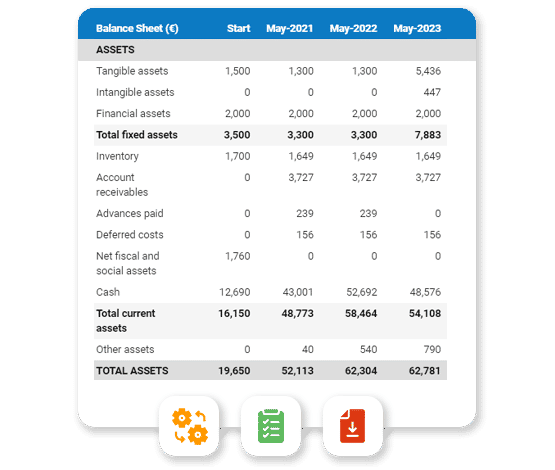
What information is used as input to build an indoor football venue financial forecast?
A indoor football venue's financial forecast is only as good as the inputs used to build it.
If you are creating (or updating) the forecast of an existing indoor football venue, then you mostly need your accounting information, key historical operating non-financial data, and your team’s input on what to expect for the coming years.
If you are building financial projections for an indoor football venue startup, you will need to have done your research and have a clear picture of your competitive environment and go-to-market strategy so that you can forecast sales accurately.
For a new venture, you will also need a precise list of the resources needed to keep the indoor football venue running on a day-to-day basis and a list of the equipment and expenditures required to start the business (more on that later).
Let's now take a closer look at the elements that make up your indoor football venue's financial forecast.
The sales forecast for an indoor football venue
The sales forecast, also called topline projection, is normally where you will start when building your indoor football venue financial forecast.
Creating a coherent sales projection boils down to estimating two key drivers:
- The average price
- The number of monthly transactions
To do this, you will need to rely on historical data (for an existing business), market research data (for both new and existing indoor football venues), and consider the elements below:
- Weather conditions: As an indoor football venue, your business may be affected by extreme weather conditions such as heavy rain or snow. This may result in decreased foot traffic and ultimately lower average prices and monthly transactions.
- Local competition: Your business may face competition from other indoor sports facilities in the area. If there are multiple options for customers to choose from, it may impact your average price and monthly transactions.
- Seasonal demand: Depending on the time of year, there may be fluctuations in the demand for indoor football. For example, during the summer months, when outdoor activities are more popular, you may experience lower average prices and monthly transactions.
- Changes in sports trends: The popularity of indoor football may be affected by changes in sports trends. If there is a sudden increase in the popularity of another sport, it may lead to a decrease in average prices and monthly transactions for your venue.
- Availability of parking: If there is limited parking available near your indoor football venue, it may deter potential customers from visiting. This could result in lower average prices and monthly transactions as it may be more convenient for them to go to a different venue with ample parking.
After the sales forecast comes the operating expenses budget, which we will now look into in more detail.
Need inspiration for your business plan?
The Business Plan Shop has dozens of business plan templates that you can use to get a clear idea of what a complete business plan looks like.

The operating expenses for an indoor football venue
Once you know what level of sales you can expect, you can start budgeting the expenses required to operate your indoor football venue on a daily basis.
Expenses normally vary based on how much revenue you anticipate (which is why, from experience, it is always better to start your forecast with the topline projection), and where your business is based.
Operating expenses for an indoor football venue will include some of the following items:
- Staff costs: These include wages, salaries, and benefits for your indoor football venue staff. This could include coaches, referees, and other administrative employees.
- Accountancy fees: You may need to hire an accountant to help with financial management and tax preparation for your indoor football venue.
- Insurance costs: It is important to have insurance to protect your indoor football venue from any potential accidents or injuries that may occur.
- Software licenses: You may need to purchase software licenses for scheduling, ticketing, and other management systems for your indoor football venue.
- Banking fees: You will likely have to pay fees for banking services, such as processing credit card payments and depositing cash from ticket sales.
- Rent or mortgage: If you do not own the building your indoor football venue is located in, you will need to budget for rent or mortgage payments.
- Utilities: This includes electricity, water, and gas bills for your indoor football venue.
- Maintenance and repairs: Regular maintenance and repairs are necessary to keep your indoor football venue in good condition for players and spectators.
- Marketing and advertising: To attract customers and promote your indoor football venue, you may need to invest in marketing and advertising efforts.
- Equipment and supplies: This includes purchasing and maintaining equipment and supplies for your indoor football venue, such as footballs, cones, and first aid kits.
- Security: To ensure the safety of players and spectators, you may need to hire security personnel or invest in security systems for your indoor football venue.
- Cleaning services: It is important to keep your indoor football venue clean and sanitary, so budgeting for cleaning services is necessary.
- Taxes and licenses: You may be responsible for paying taxes and obtaining necessary licenses for your indoor football venue.
- Legal fees: In the event of any legal issues or disputes, you may need to hire a lawyer and budget for legal fees.
- Concession expenses: If you plan on selling food and drinks at your indoor football venue, you will need to budget for concession expenses, such as purchasing inventory and paying employees.

This list will need to be tailored to the specificities of your indoor football venue, but should offer a good starting point for your budget.
What investments are needed to start or grow an indoor football venue?
Once you have an idea of how much sales you could achieve and what it will cost to run your indoor football venue, it is time to look into the equipment required to launch or expand the activity.
For an indoor football venue, capital expenditures and initial working capital items could include:
- Indoor Turf: This is a crucial element for any indoor football venue as it provides a safe and durable playing surface for players. The cost of indoor turf can vary depending on the quality and size of the venue, but it is a necessary capital expenditure for any indoor football venue.
- Lighting System: Proper lighting is essential for indoor football venues to ensure that players can see the ball and each other clearly. A high-quality lighting system can also enhance the overall experience for spectators. The cost of a lighting system can vary based on the size and design of the venue, but it is an important fixed asset to include in your expenditure forecast.
- Scoreboard and Sound System: A scoreboard and sound system are crucial for providing a professional and entertaining atmosphere for both players and spectators. The cost of these items can vary depending on the size and quality of the equipment, but they are necessary fixed assets for any indoor football venue.
- Bleachers and Seating: Providing comfortable and adequate seating for spectators is important for any indoor football venue. This can include bleachers, individual seats, and VIP seating options. The cost of bleachers and seating can vary depending on the size and design of the venue, but it is an important capital expenditure to consider.
- Locker Rooms and Facilities: Indoor football venues need to provide locker rooms and restroom facilities for players and spectators. These areas must be clean, well-maintained, and equipped with necessary amenities. The cost of building and furnishing these areas can vary, but it is an important fixed asset to include in your expenditure forecast.
Again, this list will need to be adjusted according to the specificities of your indoor football venue.
Need a convincing business plan?
The Business Plan Shop makes it easy to create a financial forecast to assess the potential profitability of your projects, and write a business plan that’ll wow investors.
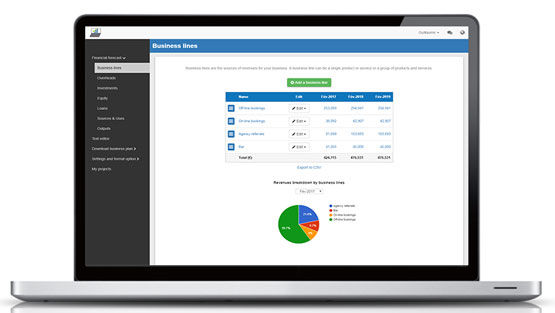
The financing plan of your indoor football venue
The next step in the creation of your financial forecast for your indoor football venue is to think about how you might finance your business.
You will have to assess how much capital will come from shareholders (equity) and how much can be secured through banks.
Bank loans will have to be modelled so that you can separate the interest expenses from the repayments of principal, and include all this data in your forecast.
Issuing share capital and obtaining a bank loan are two of the most common ways that entrepreneurs finance their businesses.
What tables compose the financial plan for an indoor football venue?
Now let's have a look at the main output tables of your indoor football venue's financial forecast.
The projected profit & loss statement
The projected profit & loss shows how profitable your indoor football venue is likely to be in the years to come.
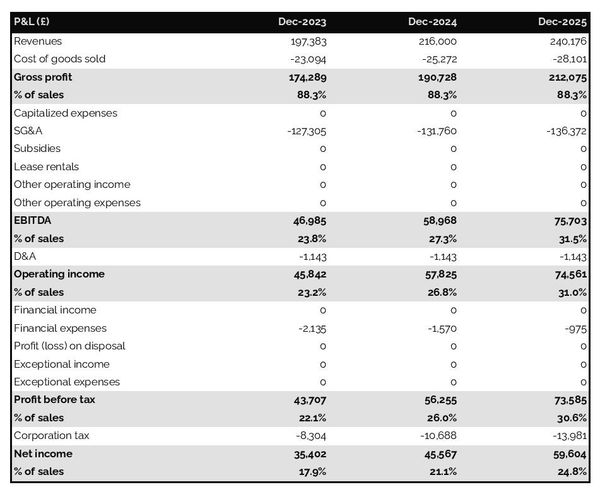
For your indoor football venue to be financially viable, your projected P&L should ideally show:
- Sales growing above inflation (the higher the better)
- Profit margins which are stable or expanding (the higher the better)
- A net profit at the end of each financial year (the higher the better)
This is for established indoor football venues, there is some leniency for startups which will have numbers that will look a bit different than existing businesses.
The projected balance sheet
Your indoor football venue's projected balance sheet provides a snapshot of your business’s financial position at year-end.
It is composed of three types of elements: assets, liabilities and equity:
- Assets: represent what the business possesses including cash, equipment, and accounts receivable (money owed by clients).
- Liabilities: represent funds advanced to the business by lenders and other creditors. They include accounts payable (money owed to suppliers), taxes payable and loans from banks and financial institutions.
- Equity: is the combination of what has been invested by the business owners and the cumulative profits and losses generated by the business to date (which are called retained earnings). Equity is a proxy for the value of the owner's stake in the business.
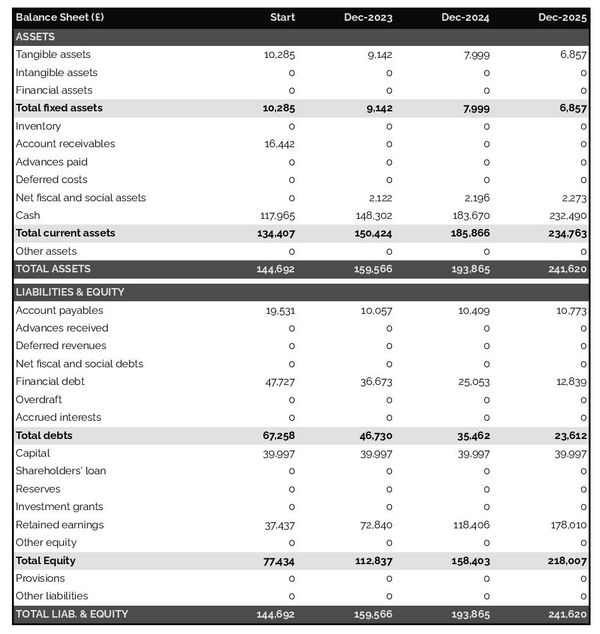
The cash flow projection
The cash flow forecast of your indoor football venue will show how much cash the business is expected to generate or consume over the next three to five years.
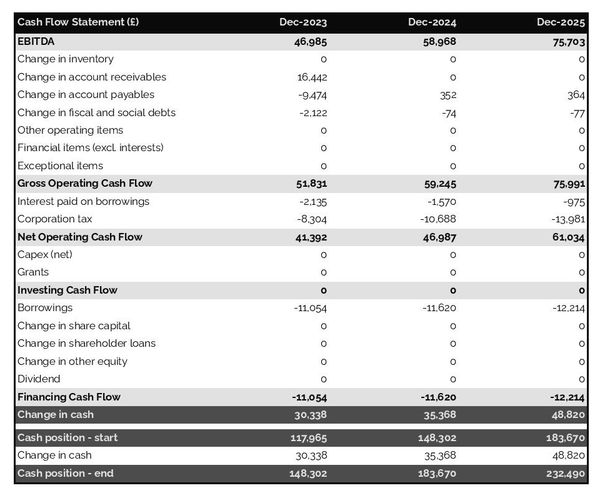
There are multiple ways of presenting a cash flow forecast but from experience, it is better to organise it by nature in order to clearly show these elements:
- Operating cash flow: how much cash is generated by the indoor football venue's operations
- Investing cash flow: what is the business investing to expand or maintain its equipment
- Financing cash flow: is the business raising additional funds or repaying financiers (debt repayment, dividends)
Your cash flow forecast is the most important element of your overall financial projection and that’s where you should focus your attention to ensure that your indoor football venue is adequately funded.
Note: if you are preparing a financial forecast in order to try to secure funding, you will need to include both a yearly and monthly cash flow forecast in your indoor football venue's financial plan.
Need a solid financial forecast?
The Business Plan Shop does the maths for you. Simply enter your revenues, costs and investments. Click save and our online tool builds a three-way forecast for you instantly.

Which tool should you use to create your indoor football venue's financial forecast?
Using the right tool or solution will make the creation of your indoor football venue's financial forecast much easier than it sounds. Let’s explore the main options.
Using online financial forecasting software to build your indoor football venue's projections
The modern and easiest way is to use an online financial forecasting tool such as the one we offer at The Business Plan Shop.
There are several advantages to using specialised software:
- You can easily create your financial forecast by letting the software take care of the financial calculations for you without errors
- You have access to complete financial forecast templates
- You get a complete financial forecast ready to be sent to your bank or investors
- You can easily track your actual financial performance against your financial forecast, and recalibrate your forecast as the year goes by
- You can create scenarios to stress test your forecast's main assumptions
- You can easily update your forecast as time goes by to maintain visibility on future cash flows
- You have a friendly support team on standby to assist you when you are stuck
- It’s cost-efficient and much cheaper than using an accountant or consultant (see below)
If you are interested in this type of solution, you can try our projection software for free by signing up here.
Calling in a financial consultant or chartered accountant
Enlisting the help of a consultant or accountant is also a good way to obtain a professional indoor football venue financial forecast.
The downside of this solution is its cost. From experience, obtaining a simple financial forecast over three years (including a balance sheet, income statement, and cash flow statement) is likely to cost a minimum of £700 or $1,000.
The indicative cost above, is for a small business, and a forecast is done as a one-shot exercise. Using a consultant or accountant to track your actuals vs. forecast and to keep your financial projections up to date on a monthly or quarterly basis will cost a lot more.
If you opt for this solution, make sure your accountant has in-depth knowledge of your industry, so that they may challenge your figures and offer insights (as opposed to just taking your assumptions at face value to create the forecast).
Why not use a spreadsheet such as Excel or Google Sheets to build your indoor football venue's financial forecast?
You and your financial partners need numbers you can trust. Unless you have studied finance or accounting, creating a trustworthy and error-free indoor football venue financial forecast on a spreadsheet is likely to prove challenging.
Financial modelling is very technical by nature and requires a solid grasp of accounting principles to be done without errors. This means that using spreadsheet software like Excel or Google Sheets to create accurate financial forecasts is out of reach for most business owners.
Creating forecasts in Excel is also inefficient nowadays:
- Software has advanced to the point where forecasting can be done much faster and more accurately than manually on a spreadsheet.
- With artificial intelligence, the software is capable of detecting mistakes and helping decision-making.
Spreadsheets are versatile tools but they are not tailor-made for reporting. Importing your indoor football venue's accounting data in Excel to track actual vs. forecast is incredibly manual and tedious (and so is keeping forecasts up to date). It is much faster to use dedicated financial planning tools like The Business Plan Shop which are built specially for this.
Need a convincing business plan?
The Business Plan Shop makes it easy to create a financial forecast to assess the potential profitability of your projects, and write a business plan that’ll wow investors.

Use our financial projection templates for inspiration
The Business Plan Shop has dozens of financial forecast templates available.
Our examples contain a complete business plan with a financial forecast and a written presentation of the company, the team, the strategy, and the medium-term objectives.
Whether you are just starting out or already have your own indoor football venue, looking at our financial forecast template is a good way to:
- Understand what a complete business plan should look like
- Understand how you should model financial items for your indoor football venue
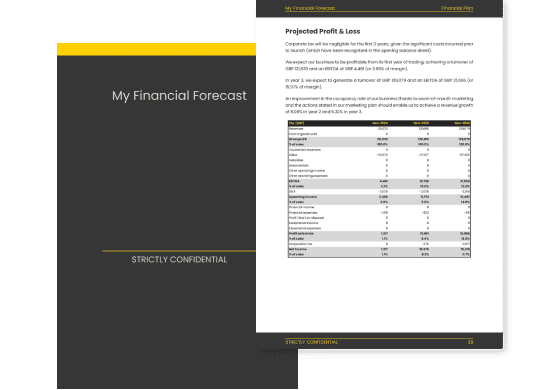
Takeaways
- A financial forecast shows expected growth, profitability, and cash generation metrics for your indoor football venue.
- Tracking actuals vs. forecast and having an up-to-date financial forecast is key to maintaining visibility on your future cash flows.
- Using financial forecasting software is the modern way of creating and maintaining financial projections.
We hope that this guide helped you gain a clearer perspective on the steps needed to create the financial forecast for an indoor football venue. Don't hesitate to contact us if you have any questions!
Need inspiration for your business plan?
The Business Plan Shop has dozens of business plan templates that you can use to get a clear idea of what a complete business plan looks like.

Also on The Business Plan Shop
Know someone who runs an indoor football venue? Share our business guide with them!

